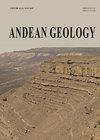晚石炭世-早二叠世碳酸盐岩-火山-湖泊-沼泽系统中的成地和陆上暴露微构造(阿根廷科迪勒拉前沿圣伊格纳西奥组)
IF 1.2
4区 地球科学
Q3 GEOLOGY
引用次数: 5
摘要
在阿根廷安第斯山脉(Frontal Cordilera),晚石炭世-早二叠世San Ignacio组的上部由湖相沼泽微生物碳酸盐岩和互层火山沉积物组成。在这种湖泊沼泽环境中,形成了一种天然的单特异性森林。该沉积火山序列的沉积物多次受到陆上暴露,并在不同程度上受到成土作用的改变,从而导致古土壤的发育。碳酸盐岩和火山岩中保存完好的成岩微构造。碳酸盐微组构包括广泛的特征,包括根痕和树桩相关结构(节肢动物的根状体、肺泡结构、隧道状结构和粪化石)、豆状物、涂层颗粒和假微岩溶、开裂、角砾化和结节状组构,颗粒化也对应于成土演化的不同阶段。观察到流星溶解和胶结过程;通过扫描电子显微镜很好地鉴定了实例,其显示在部分溶解的碳酸盐中二氧化硅填充的空隙以及空隙中无机碳酸盐微晶或微生物来源的生长。可以看到其他不同类型的胶结物,如不连续的碳酸盐结壳、带状晶石、带有淤泥填充物的空腔和悬垂胶结物。整套这些微组构表明了湿润、干燥和大气环境条件(渗流和潜水)。丰富的植物根系和主要由细菌来源的相关微生物(微棒、短棒形状、纳米纤维、细丝和纳米球体)在影响这些沉积物的成土和陆上成岩过程中发挥了重要作用。古土壤的不成熟特征和钙质混凝土的缺乏表明,由于水位的振荡波动、间歇性火山供应、构造沉降和振荡的气候条件,陆上暴露的时间间隔很短。整个宏观和微观构造表明,主要天气可能介于半干旱和亚湿润之间,但化石森林发育的干湿交替条件以及微生物的丰富性和多样性表明,气候条件已过渡到亚湿润。本文章由计算机程序翻译,如有差异,请以英文原文为准。
Pedogenic and subaerial exposure microfabrics in a late Carboniferous-early Permian carbonate-volcanic lacustrine-palustrine system (San Ignacio Formation, Frontal Cordillera, Argentina)
In the Argentinian Andes (Frontal Cordillera) the upper part of the late Carboniferous-early Permian San Ignacio Formation is made up of lacustrine-palustrine microbial carbonates and interbedded volcanic deposits. In this lacustrine-palustrine environment a natural monospecific forest was developed. The deposits of this sedimentary-volcanic succession were repeatedly subjected to subaerial exposure and modified by pedogenesis to varying degrees giving rise to paleosoils development. Diagenetic microfabrics were well preserved in the carbonates and volcanic rocks. The carbonate microfabrics comprise a wide spectrum of features consisting of root marks and stumps-related structures (rhizoliths, alveolar texture, tunnel-like structures and coprolites of arthropods), pisoids, coated grains and pseudomicrokarst, cracking, brecciated and nodular fabrics, and grainification also occur corresponding to different stages in the pedogenic evolution. Meteoric dissolution and cementation processes are observed; examples are well identified by scanning electron microscope showing silica-filled voids in partially dissolved carbonates and growths of inorganic carbonate microcrystals or of microbial origin in voids. Other different types of cements can be seen such as discontinuous carbonate crusts, ribbon spar, cavities with silt infillings and pendant cements. The whole set of these microfabrics are indicative of wetting, desiccation and meteoric conditions (vadose and phreatic). The abundance of plant roots and associated micro-organisms mainly of bacterial origin (micro-rods, short rod-shapes, nano-fibres, filaments and nano-spheres) played an important role in the pedogenic and subaerial diagenetic processes affecting these deposits. The immature character of the paleosoils and absence of calcretes point out to short intervals of subaerial exposure due to oscillating fluctuations in water level, intermittent volcanic supply, tectonic subsidence and oscillating climatic conditions. The whole of the macro and microfabrics reveals that the prevailing weather could correspond to an intermediate between semi-arid to sub-humid, however the alternating wetting and drying conditions in which the fossil forest developed and the abundance and diversity of micro-organisms, suggest a transition to sub-humid climate conditions.
求助全文
通过发布文献求助,成功后即可免费获取论文全文。
去求助
来源期刊

Andean Geology
地学-地质学
CiteScore
3.90
自引率
0.00%
发文量
17
审稿时长
>12 weeks
期刊介绍:
This journal publishes original and review articles on geology and related sciences, in Spanish or English, in three issues a year (January, May and September). Articles or notes on major topics of broad interest in Earth Sciences dealing with the geology of South and Central America and Antarctica, and particularly of the Andes, are welcomed.
The journal is interested in publishing thematic sets of papers and accepts articles dealing with systematic Paleontology only if their main focus is the chronostratigraphical, paleoecological and/or paleogeographical importance of the taxa described therein.
 求助内容:
求助内容: 应助结果提醒方式:
应助结果提醒方式:


